| |
|
|
INTRODUCTION
Preparing for this lecture, the authors were considering whether
the twenty-five years of the continuous duration of the "Ecological
Truth" was a long enough period to look back and find out which one
of the benefits of such a scientific conference of international
reputation was used, and how far the development of ecological idea
has gone and which way it should go further. Furthermore, is
something like that so necessary at all today, when the "Ecological
Truth" continues its way on, as it was before? For the first time,
such a look back was made after ten such conferences [1]. It was
quite a lot of work that needed to be done: regarding the definition
of ecology and harmonization of ecological terms and concepts,
expert-methodological and essential approach to ecology as a science
and the possibilities of its use in everyday life. Ecology is a
young science, with an interesting history. The term "ecology" was
first used by Ernst Hekel, a follower of the great Darwin, defining
it through the relations with the surrounding environment including,
in the broadest sense of the word, all the existential relationships
of living beings and the environment [2]. Ecology is the science of
life, which provides the scientific basis for the protection of
nature. The term human ecology is also used, most often when it
comes to ecological analyses and activities that go hand in hand
with the leading political elites and modern economies and their
institutions, in order to maintain production that is harmful to the
environment and when it wants to maintain an environmentally harmful
order - homo tehnicusa [3].
The definition of ecology and functioning of the ecosystem is also
found in the "Framework of Life" [4] of our scientist Sinisa
Stankovic, born in Zajecar.
WHAT PRECEDED ECOLOGICAL TRUTH?
Hygiene - medical ecology
In the sixties of the last century, at the time when the
development of industrialization took place, it was necessary,
within the framework of the program of "reconstruction and
development of socialism" in Yugoslavia, to build factories, restore
mines, build electric power plants, railways and roads in the Timok
region, to restore the economy as a whole, and to increase the
production especially in Bor and Majdanpek. We will also mention
here the impacts on the nature, life and health of the population
that were created by the construction of the HPP "Djerdap I", where
the interventions on the Danube and the riverbank were such that
they significantly influenced the flora, fauna and population both
on our and Romania's side. At that time, the ecological fate of this
area was altered.
At that time, the Institute of Hygiene in Zajecar was founded with a
purpose to monitor the impact of the environment on human health, at
first, in industrial plants, and later to spread out, to control the
impact of air, noise, lighting and temperature in the manufacturing
plants on the health of workers, and later the quality of toxic
gases and wastewater from industrial plants and other harmful
effects on the environment. Doctors were sent to specialize in
hygiene, a medical science with attributes of medical ecology. The
institute was equipped with adequate equipment, it employed
technicians, chemists and toxicologists and gave the first results
regarding the state of the environment in the Timok Krajina region.
Bor mine - the biggest polluter of the environment in
Yugoslavia
The results of laboratory investigations of the quality of air,
watercourses and soil clearly show that in the seventies, Bor and
its surroundings were the most polluted and most devastated areas in
Yugoslavia. The Timok river became a collector of industrial waters
of the Bor copper mine, in which every form of life ceased to exist.
It should be said that the Timok river was at the same time a
collector of wastewaters from the industry and cities of Knjazevac,
Zajecar and Boljevac. During the spring floods, the Timok was
poisoned by poisonous pyrites and it permanently destroyed fertile
soil from the Vrazogrnac river to its confluence in the Danube from
year to year. The peasants from Brusnik, Bracevac, Tamnica, Rajac,
Rogljevo and Kovilovo were left without more than a thousand
hectares of fertile land. The peasants from the Bulgarian villages,
downstream of Bregovo, suffered damage too.
As far as the Bor mine is concerned, in all the reports and
analyses, which always had the significance of a political message,
there were always just praises. No harmful impacts on the
environment, nor a proposal for measures to stop further degradation
of nature and sanitize the consequences. A similar situation was in
Majdanpek. The Country needed copper and gold. The political and
economic elites in Yugoslavia were satisfied.
Ecological incidents, rebellions and meetings
The peasants, who were partly miners in nearby mines and
factories in the cities nearby, weren’t satisfied with the progress
of industry and mining in the Timok region. After World War I, the
development of mining in this region caused the degradation of the
land and the great dissatisfaction of the population due to such
destruction of nature and fertile soil. It was the reason for the
peasants' rebellions in the surrounding of Bor, below Rtanj and in
the vicinity of Vine. Thus, the "Bulletin of the Moravian Banovina
Chamber of Commerce" published in the number 3, January 1, 1939, the
following article: "The coal mine Rtanj discharges its coal mine
black water in the Mirovstica River, and further into the Black
River. From polluted water, the fish died and the animals were
killed, especially during drought. Taking this into account, our
chamber has threatened the Ministry of Forests, Mines and Banks,
asking to protect the interests of agriculture in this region [5]".
Much worse situation was in the vicinity of Bor and along the Borska
river and in the vicinity of other mining and industrial plants
between the two wars. On May 7, 1935, the following was written
about the rebellion of peasants from the Bor region in the Letopis
of Bor Parrohi and the Church: „On that day, peasants from Bor,
Slatina, Krivelj, Ostrelj, Brestovac, Bucje, Metovnica and Bela
Reka, with skillful concentration and sudden attack, stopped the
operation of the copper smelter in the Bor mine after they had
beaten some of the personnel in the smelter and banned the work.
They were desperate and forced to do it because of the destructive
effect of poisonous smoke from the smelter on their crops, soil and
cattle. From that day till the 31st of May the smelter did not work,
so there was the grace to watch the plants develop and the fields
covered by greenery. In the absence of toxic smoke from the smelter,
farmers' crops began to progress and even some birds that had not
existed before appeared, and with their tweetment, gave life and joy
to nature. But on June 1, the Smelter started working again and the
smoke from it began to cover, with the fading death, trees, grass,
fields, and even the birds under its influence were expelled. - Ah!
When will the poisonous effect of this smoke finaly disappear ? When
the righteous desire of the peasant will be fulfilled, that the
smoke does not destroy the soil, his cattle and his health! [6]".
After the demolition of a dam on the lake where waste waters and
pyrite from the mine in Majdanpek were collected, the village of
Debeli Lug and the riverbank area were flooded to the mouth of the
river Pek into the Danube. Residential buildings, stables and yards
in Debeli Lug were flooded with toxic wastewater and pyrite, arable
land was endangered and living organisms were destroyed in the water
of the Pek River and the Danube.
In the mid-seventies of the 20th century, the communal environment
of Zajecar was burdened with industrial pollution from a glass
factory, from steam locomotives at the railway station and
individual fireplaces. The public was especially harassed by the
pollution from industrial plants in the glass factory. In those
years, the measurement of air pollution in the communal environment
started. After three years of measurement, it was shown that the air
was polluted by the contents of the vapor from the glass factory,
and it was ordered that measures be taken to reduce the pollution.
There were suggestions that the railway station should be moved to
another location, thus reducing air pollution by smoke from steam
locomotives. This did not happen because these were soon replaced by
electric motor trains. In Bor, the situation was even worse, because
the level of pollution in the municipal environment of industrial
gases was above the maximum concentration allowed daily.
The situation did not improve much, so the population's
dissatisfaction led to an ecological meeting in the center of
Zajecar in the early 1990s, attended by about 3,000 people. A few
days later an ecological meeting was organized in Bor, too [7].
Figure 1 Ecological meetings in Zajecar and Bor
Slika 1 Ekološki skupovi u Zaječaru i Boru
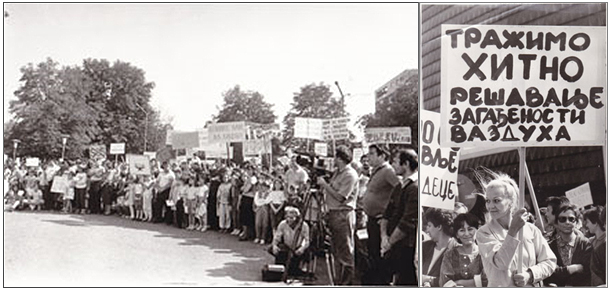
Such a public opinion process was inspired by the increased
involvement of professional institutions from Zajecar and Bor, in
solving the ecological crisis in the Timok Krajina region and
establishing an environmental tribune "Ecological Truth".
The Stockholm Conference in 1972 and her echo in Timok Krajina
The first United Nations Conference on the Human Environment was
held in Stockholm in 1972. This Stockholm Conference marked a
milestone in the relationship between humanity and the environment.
The first day of the Conference in Stockholm, June 5, was proclaimed
World Environment Day (WED). From this Conference, a malicious,
apocalyptic message spreads, that if the pollution and destruction
of nature, continues at the same pace, life on earth will disappear
in the next 50 years! Warning alarm was on as a reminder that
natural resources can not be exploited uncontrollably and
excessively without consequences for the overall humanity. In the
focus of interest, the "polluters", protected by politics, were
found in the focus of interest in the whole of the Timok River
basin, and over the hill, in Majdanpek. Cadastres of polluters were
being made rapidly. At first, the state was satisfied that
"polluters" were paying expensive ecological taxes, because of the
damage they inflict on nature. Problems to be solved are very
complex and expensive for interventions to be taken on obsolete
technologies and to make their harmful effect to nature more
tolerable. The problems caused by the development of all cities and
the urbanization of the Timok Krajina region should be also added to
all this. There was a need to deal with the problems created by
intensive industrialization of the Timok region by developing
institutions and strategies based on science in the field of nature
protection from industry and obsolete technologies.
Echo of the Conference in Rio in 1992 - new approaches to ecology
The Rio de Janeiro Conference, twenty years after the Stockholm
conference, focused on preserving natural values, especially on
biodiversity. While the first was concerned with environmental
issues, the second tackled environmental and developmental issues
and was known as the World Earth Summit. The global concept of
sustainable development was officially accepted and adopted at this
conference [8].
The Institute for Health Protection "Timok" in Zajecar has
introduced a new philosophy in the ecology of the Timok Krajina
region, which also reflects on the contents of the work of
"Ecological Truth". At the time when this was not taken into account
in Serbia, and when many did not know what biodiversity is, the
Institute initiated and organized the scientific conference "Our
Ecological Truth", thus drawing attention to new approaches to
ecology.
The following attitude is taken into account: it is better to
protect natural biodiversity more effectively than to wage war with
"polluters". So the issue of ecological education came to the
agenda. The results of the research unambiguously indicated low
ecological awareness among the population and insufficiently
developed health culture.
The Institute offered a school system the Ecological education
program, which began to be applied in some secondary schools in Bor
and Zajecar. Elementary school in the village of Krivelj had
organized for several years "School of ecology" in the village of
Gornjane, to which came elementary school pupils from several cities
from Serbia and Vojvodina. The papers about ecological education
referenced in a series of scientific conferences of "Ecological
Truth" is a proof of the echo the Conference in Rio had in our area.
Community for Science and "Ecological Truth"
Nikola Sainovic started the founding of the Society for Science in
Bor in 1986. The first scientific project for the protection of the
human environment was related to the so-called. «Floodplain»,
created after the construction of the hydroelectric power plant "
Djerdap I".
Figure 2 Participants of the "School of ecology"
in the village of Gornjane
Slika 2 Učesnici "Škole ekologije" u selu Gornjane
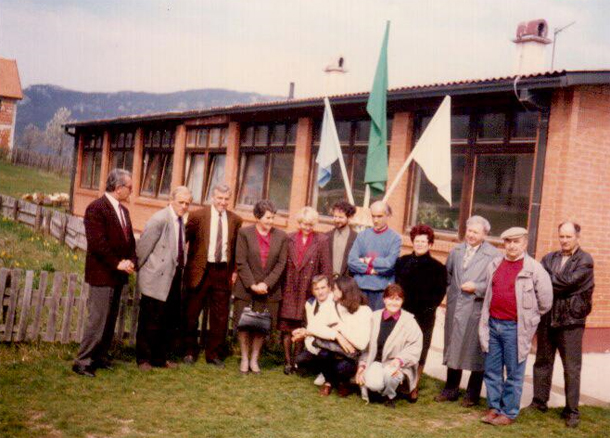

It was hosted by several institutions and researchers, led by
Academician Vojislav Petrovic, professor of biology, born in
Krajina, a former professor of Negotin Gymnasium. Several doctors
from the area of the Timok region, who wanted a taste of the eternal
grail of science, were also included in a large team of experts of
the project. A microbiologist, a toxicologist and a doctor of
preventive medicine were engaged in the Institute for Health
Protection "Timok" Zajecar, together with the Institute for Copper
in Bor and the Technical Faculty in Bor and the Institute seriously
began to deal with ecology. We had laws, a scientific community,
institutions, but there was something else missing: an environmental
forum where research results, environmental ideas, research
approaches, discussions, research and interventions in a damaged
nature could be presented. And most importantly, to offer efficient
expert solutions to factories and the state and to facilitate the
implementation of environmental laws.
What was at first interesting was the fact that researchers began to
pay attention to the risks and health-related hazards caused by
industry and technology. And not only that.The presence and
engagement of the Institute in Zajecar has contributed to the
protection of nature with special values: moral, institutional and
scientific.
During participation in the work of the Community of Science, Rade
Kojdic - Cica, Director of the Institute of Copper Bor, Director of
the Zavod for Health Protection "Timok" Zajecar, Dr Petar Paunovic,
and Toplica Marjanovic from Bor, launched an initiative for holding
an annual professional and scientific conference "Our Ecological
Truth", later "Ecological Truth", today "Ecological Truth and
Environmental Research".
The first Conference entitled "Our Ecological Truth", was held on
June 5, 1993 in Zajecar. The representatives of the Ministry of
Environmental Protection, local governments, businesses, NGOs, the
media and doctors of medical centers of the cities in the region of
Timok Krajina took part in the conference. The papers from this
scientific conference were published in the Journal "Razvitak" in
Zajecar.
Figure 3 Journal "Razvitak" from 1993
Slika 3 Časopis "Razvitak" iz 1993. godine
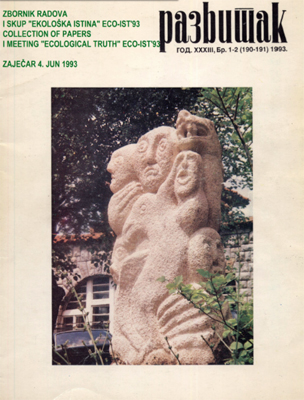
Our Ecological Truth and Radioactive Waste from Vinca
Soon after its establishment "Our Ecological Truth", slowly began
to transform itself into ecological movement of Timok Krajina
region. It has become a serious institution of ecological activities
on political, professional and social plan. In the middle of the
90s, during a scientific and expert meeting held on Borsko Lake, Dr
Jordan Aleksic, minister of Ecology and Environmental Protection of
the Republic of Serbia, raised a question regarding the radioactive
waste from Vinca, having a doubt that the waste had been deposited
in the abandoned uranium mine in Kalna [9].
Kladovo Community has raised the issue of pollution of the Danube by
radionuclides from the waste waters coming from those European
countries through which this big river flows. The community was also
looking for a solution on how to protect vegetable fields from the
destruction caused by acid rains formed due to air polluted by
industrial emissions from the factories in Turn Severin, in
neighboring Romania. This opened up a space for researchers and
topics that found their place in the programmes of scientific –
expert meetings of Ecological Truth.
LEAP - Local Environmental Action Plan
Numerous and varied activities in the field of environmental
protection enabled the LEAP - local environmental action plan to be
created at the beginning of a new period in 2000, in order to ensure
the continuity of human environment protection. The largest number
of municipalities in the Timok Krajina region have developed
ecological plans upon state's directives, but these have not been
revised, due to political and economic crisis. "Ecological truth"
continued to live in spite of the war and the mentioned crisis.
TWENTY-FIVE YEARS OF ECOLOGICAL TRUTH
"Ecological Truth" is a traditional scientific and professional
conference, today a conference devoted to environment, ecology,
public health, sustainable development, and its primary goal is to
raise ecological awareness. It has been held for 25 years and, most
importantly, it fulfills this mission.
"Ecological Truth" began in 1993 as a national conference, later a
national scientific with international participation, and today it
is an international conference. In the past two decades, "Ecological
Truth" has developed and gone through certain phases of its
development. However, the years 1994, 1996, 1998, 1999, 2003 and
2010 represent the milestones in the development of the "Ecological
Truth".
In the spring of 1994, the Institute offered cooperation to the
Society of Young Researchers and to the Mining and Smelting Combine
Bor to jointly continue with the organization of this event. This
was one of the crucial moments when the foundations of future
organization and cooperation were laid. On this occasion, some
strategic decisions were made:
1. "Our Ecological Truth" was to become a multidisciplinary
scientific-expert conference on natural values and environmental
protection, where the latest scientific, theoretical, expert
knowledge and practical experience of experts of different profiles
(engineers, doctors, biologists, geographers, free planners ,
economists, lawyers, pedagogues) would be heard.
2. At the same time, the "Days of Preventive Medicine of Timok
Krajina", which, by then, had already been organized for five years,
was to be organized together with the "Ecological Truth".
3. Apart from the Institute, some other professional and scientific,
health and economic organizations as well as non-governmental
organizations from Bor and Zajecar would be included in the
organization of the Conference.
4. The Conference should become traditional and be organized in all
the cities of Timok Krajina.
According to the number of papers, authors and co-authors, as well
as the participants, the second "(Our) Ecological Truth" was the
most massive event to date. A Proceeding of abstract papers was
prepared for the Conference (up to 2 pages per work).
Each new conference brought up some new dilemmas and sought answers
to new questions. Preparations for the third conference began with
the question: Should such a Conference be organized each year? Do we
have enough knowledge, readiness, organizational and financial
capabilities? The solution was found in the establishment of
cooperation between professional and scientific institutions,
economy, local self-government and non-governmental sector, which
ensured successful organization.
The following co-organization of the conference in 1995, included
the only state higher education institution in the Timok Krajina
region, the Technical faculty in Bor. The Technical faculty in Bor
had actively participated in co-organizing of the event until 2002,
and since 2003, until today, it has been the main organizer of the
"Ecological Truth". During this period, the Technical faculty in Bor
has made a considerable contribution to the realization of the idea
begun in 1993.
In 1996, this scientific conference was named "Ecological Truth" at
the proposal of Assist. Prof. Dr. Goran Belojevic from the Institute
of Hygiene and Medical Ecology at University of Belgrade, who was
one of his regular participants.
In 1998, it brought in some new things, which enriched the content
and program of this event and brought it closer to the wider public.
From the beginning, one of the basic goals of the Conference was the
affirmation of the research work of young people. At the sixth
meeting, in 1998, for the first time they had the opportunity to
present their papers to pupils and students within the special
section " Scientific youth", and this idea was also accepted at
other scientific meetings in Serbia.
The "Ecological Truth" was the only traditional scientific
conference organized in wartime in 1999. It was held in Zajecar on
the last day of the NATO bombing and on the first day of peace.
Due to a large interest shown by many experts from the country and
abroad, this conference further developed and on its 18th birthday
in 2010, for the first time it was held as international conference
and out of eastern Serbia. The venue was in Banja Junakovic near
Apatin, in Vojvodina. Accepted papers are printed in English in
Proceedings. The title of the conference was the International
Conference "Ecological Truth", officially used by 2017. The late
Prof. Dr. Zoran S. Markovic then stated: „This is one of the
multidisciplinary, international conferences in Serbia that has the
official approval of the Ministry of Education, Science and
Technological Development.“
In 2010, of the previous co-organizers, there only remained the
Society of Young Researchers from Bor; new co-organizers were:
Zapadno Bacка Administrative District Sombor, Public Health
Institute of Sombor, Vojvodina Forest of Sombor, Chamber of Commerce
Novi Sad, DP „Agroinstitut“ Sombor, Municipality of Apatin and
Sombor City.
Figure 4 Participants of the "Ecological Truth" in
Zajecar, 1999.
Slika 4 Učesnici "Ekološke istine" u Zaječaru, 1999. godina
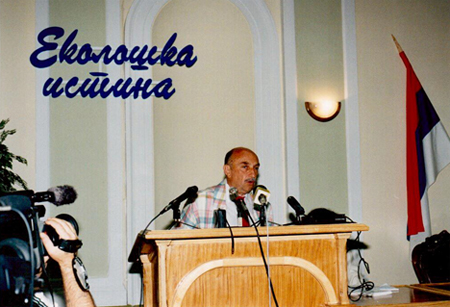
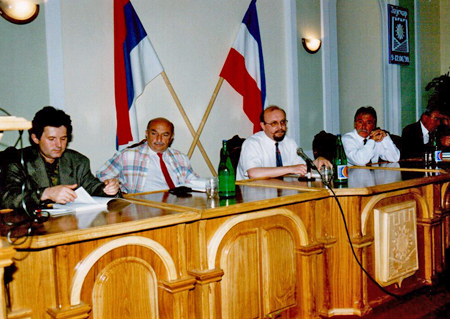
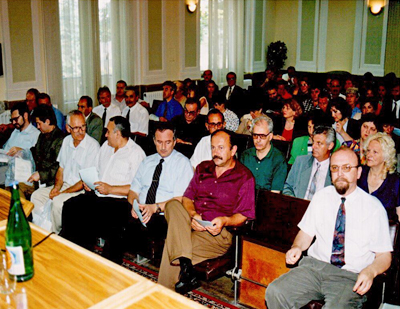
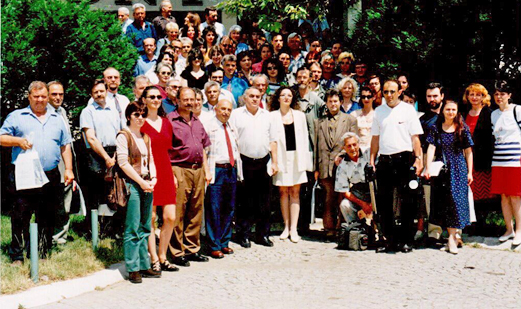
Bearing in mind that in the realization and affirmation of
"Ecological Truth", various government, professional and scientific
and numerous non-governmental organizations have participated from
the very beginning, it is necessary to get to know the nature and
basic characteristics of "Ecological Truth".
The basic characteristics of the Conference "Ecological Truth"
аre:
- Science and expertise: the main goal is the presentation of
scientific and professional papers reviewed by the Scientific
Committee. All papers were published in special Proceedings, which
affirmed the participants and their ecological activities.
- Multidisciplinarity and interdisciplinarity: the organizer's
desire was to gather experts from different profiles at the same
place and to share knowledge about the environment and people's
health from the aspect of different sciences, and also to point out
possible solutions to the same topic.
- Relevancy and adaptability to the needs of the time: the number of
different topics and sections in which they are dealt with can
always be searched for current scientific developments and practical
needs of the society. Some sections expanded their scope of work and
introduced new sections with contemporary content, for example,
since 2001, there has been a session on the Local Environmental
Action Plans (LEAP), which became a special topic at the moment when
we began to talk about these plans.
- Affirmation of research work of young people: since the first
scientific conference special attention has been paid to the
affirmation of the research work of young people.
- Co-operation and capacity building of the local community: the
organization of such an event required the establishment of
cooperation of the entire community. One of the goals was to achieve
cooperation and strengthen the capacities of all sectors: government
(local self-government), business sector, professional and
scientific institutions and non-governmental organizations.
- Publicity: the conference is seen as an opportunity to inform the
public about new scientific knowledge about the environment.
Therefore, from the beginning, all the information has been
available to the media and every opportunity was used to talk and
write about it.
An analysis of the results achieved at the professional and
scientific conference "Ecological truth" is one of the basic tasks
of the author of this lecture. Tables 1 to 8 provide statistical
analysis of results and events in the period from 1993 to 2017.
The number of published papers at the conference "Ecological Truth"
from 1993 to 2017 is presented in tables 1 – 3.
Table 1 Number of published papers on the national scientific and
professional conference
"Our Ecological Truth" (1993-2002)
Tabela 1 Broj objavljenih radova nacionalne naučno-stručne
konferencije
"Naša Ekološka istina" (1993-2002)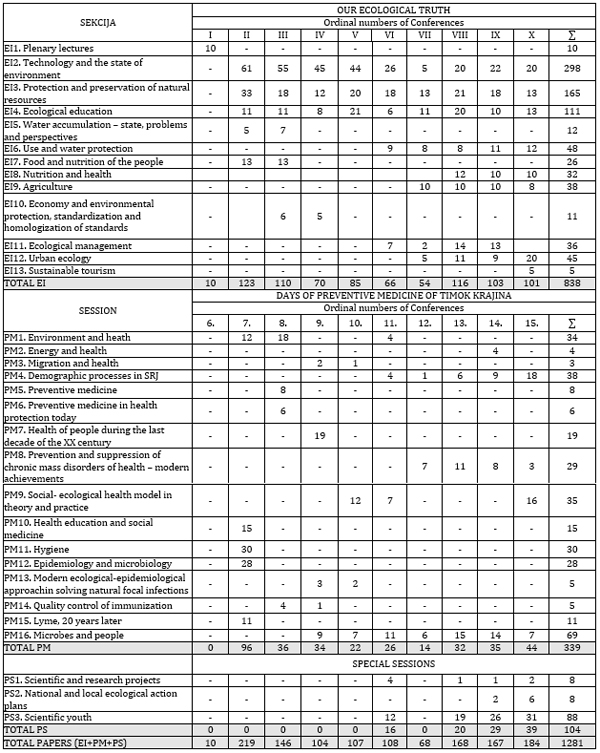
Table 2 Number of published papers on the scientific and
professional conference on natural resources
and environmental protection "Ecological Truth" (2003-2009)
Tabela 2 Broj objavljenih radova nacionalne naučno-stručne
konferencije na temu prirodnih resursa
i zaštite životne sredine "Ekološka istina" (2003-2009)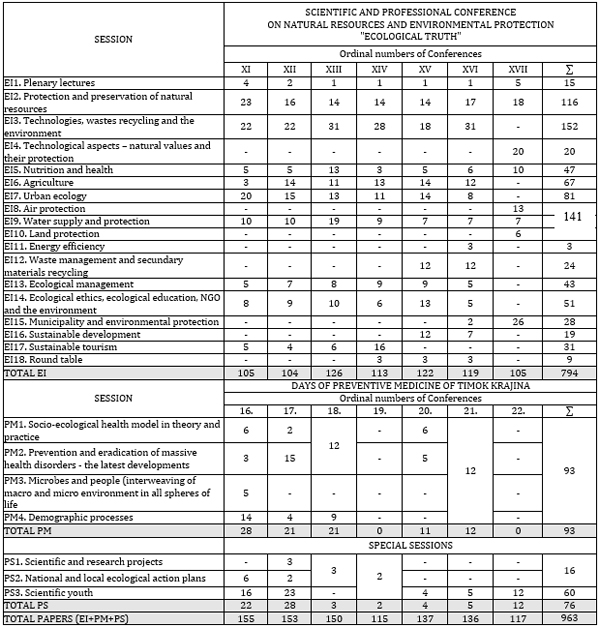
Tabela 3 Number of published papers on the International
scientific – professional conference
“Ecological Truth”(2010-2017)
Tabela 3 Broj objavljenih radova o međunarodnoj naučno-stručnoj
konferenciji “Ekološka istina”(2010-2017)
The organizers and co-organizers of the conference "Ecological
Truth" from 1993 to 2017 are presented in tables 4 – 6. The venue
and the Presidents of the Scientific and Organizing committee of the
conference "Ecological Truth" from 1993 to 2017 are presented in
table 7. The number of authors and publications of papers at the
conference "Ecological Truth" from 1993 to 2017 are presented in
table 8, too.
Table 4 Organizers and co-organizers of the national scientific and
professional meetings
“Our Ecological Truth” (1993-2002)
Tabela 4 Organizatori i suorganizatori nacionalnih naučno-stručnih
skupova
“Naša Ekološka istina” (1993-2002)
Table 5 Organizers and co-organizers of the scientific and
professional conference on natural resources
and environmental protection "Ecological Truth" (2003-2009)
Tabela 5 Organizatori i suorganizatori naučno-stručne konferencije
na temu prirodnih resursa
i zaštite životne sredine "Ekološka istina" (2003-2009)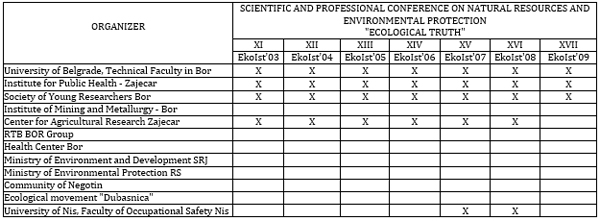
Table 6 Organizers and co-organizers of the International
scientific – professional conference
"Ecological Truth" (2010-2017)
Tabela 6 Organizatori i suorganizatori međunarodne naučno-stručne
konferencije
" Ekološka istina " (2010-2017)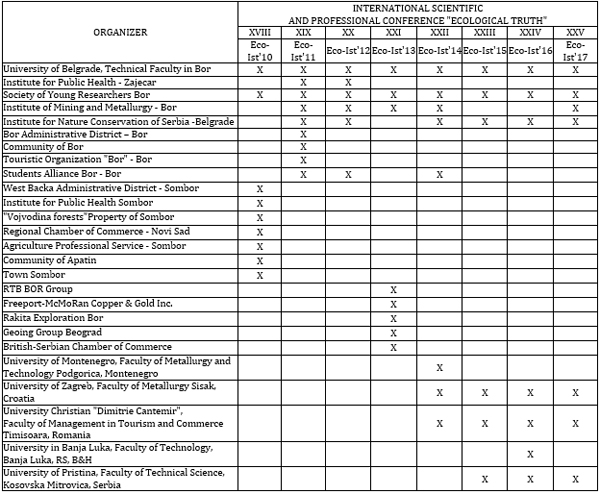
Table 7 Venue and the Presidents of the Scientific and Organizing
committees
Tabela 7 Mesto održavanja konferencije i Predsednici Naučnog i
Organizacionog komiteta
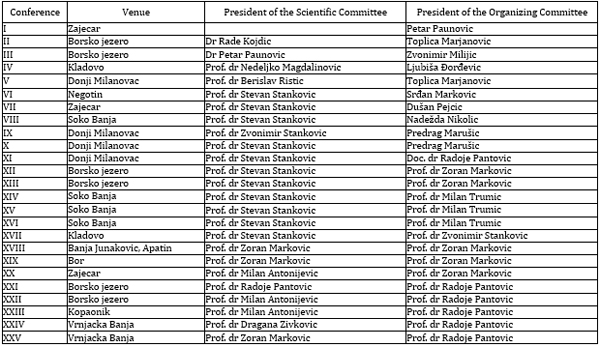
Table 8 Number of authors and publications of papers
Tabela 8 Broj autora i objavljivanje radova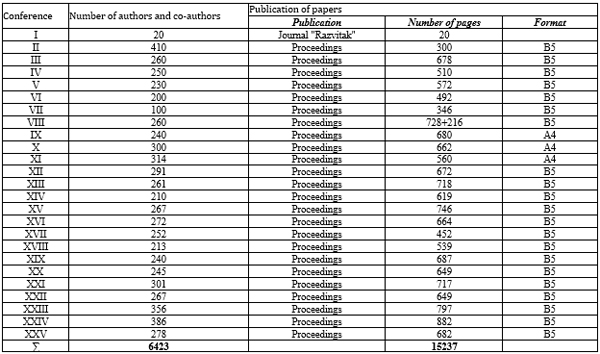
During the previous period, in these twenty-five professional and
scientific meetings, including the Day of Preventive Medicine, 2915
papers were published in 30 different sections. In the section
"Scientific Youth" 168 papers were published, which makes a total of
3083 papers. Also, twenty-five Proceedings (22 formats B5 and 3 A4
formats) were printed on a total of 15237 pages. The conference was
attended by over 6423 authors and co-authors of papers and a large
number of invitees, guests, journalists and interested individuals.
"Ecological Truth" was organized in 7 cities of Timok krajina and 3
cities outside Timok Krajina. The Organization was led by 12
Presidents of the Organizing Committee, while 10 prominent
scientists chaired the Scientific Commmittees that took care about
scientific and technical values of the Conference.
INSTEAD OF THE CONCLUSION
"Ecological Truth" is the only conference in this region, and
wider, which has gathered all generations for the last twenty-five
years, from pupils and students to professors and foreign research
workers.
A large number of experts contributed to the success of the
"Ecological Truth" from the Institute and from many other institutes
and faculties, the Institute for Health Care in Serbia and other
organizations, such as the "Society of Young Researches".
The Society of Young Researchers Bor has been one of the permanent
co-organizers of the scientific-orifessional meeting "Ecological
Truth" since the first conference in 1993. Since then, the
co-organizers have been changed and among the large number of new
co-organizers, the Society of Young Researchers Bor is the only
traditional co-organizer.
A special contribution was made by the Military Medical Academy in
Belgrade with its professors Mirce Obradovic and Spiro Radulovic,
prof. Stevan Stankovic from the Faculty of Geography as a long-time
president of the Scientific Committee, late prof. Zoran S. Markovic
from the Technical Faculty in Bor and others.
In addition to scientific-professional work, special attention was
paid to accompanying activities. The goal of numerous excursions was
to get acquainted with the culture and natural heritage of eastern
Serbia, and later Apatin, Kopaonik, Goc and Vrnjacka Banja.
Participants of the event had the opportunity to get to know the
beauties of the Lazarev canyon and the Zlotska cave, the Djerdap
Gorge, the Bor Lake, the Moravica canyon and the thermo-mineral
springs Sokobanja. Travelling by boat, they met the values of the
Danube and cultural treasures of Kladovo, Apatin. They visited the
first urban settlement in Europe, "Lepenski Vir", visited Rajacke
pimnice, Sokograd, Jama, Vidikovac, RTB Bor, then museums in Negotin
and Zajecar, the birthplace of Stevan Mokranjac and many other
cultural sights.
Finally, we can say that "(Our) Ecological Truth" has great
strength. Its strength is reflected in its successful living and
being held every year in the 21st century.
ACKNOWLEDGEMENT
The author kindly thanks Professor Danko Nikolic for his
professional help in translation of the text and Toplica Marjanovic
on the statistical processing of the results in the first ten years
of Ecological Truth. Special thanks go to Prof. dr Jovica Sokolovic
from Technical faculty in Bor in the preparation of this paper and
the analysis of the results achieved in the past 25 years of
‘’Ecological truth’’.
REFERENCES
- Paunovic P, Book of the Institute, ideas, achievements,
experiences, possibilities, Institute for Health Protection,
Timok, Zajecar;2006.
- Häckel E., Natürliche schöpfungsgeschichte, G. Reimer,
Berlin (1868).
- Park R.E, Burgess E.W. Introduction to the Science of
Sociology, Chicago ,University of Chicago Press;1921.
- Stanković S. The framework of life - the principles of
ecology, , Belgrade Nolit;1933.
- Bulletin of the Moravian Banovina Chamber of Commerce, 3,
(1939).
- Djordjevic A., The Letopis Bor Parrohi and the Church, Bor
(2007).
- Paunovic P. Ecological Meeting, The Lexicon of the health
culture of Timocke Krajina, Available from:
http://leksikon.zavodzajecar.rs/index.php/e/108-2016112302,
Accessed on: 04 April 2018.
- Stanojlovic R., Sokolovic J., Technologies and Sustainable
Development, University of Belgrade, Technical Faculty in Bor,
Bor ;2016.
- Lazarevic M. Lies, more toxic than uranium, Timok, Zajecar
;1996.
10. Proceedings from the conference "Ecological Truth" from 1993
to 2017;2017.
|
|
|
|
















